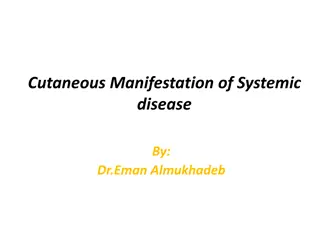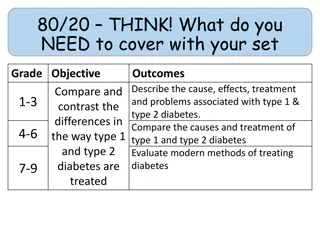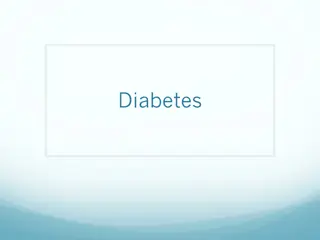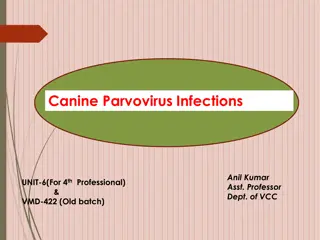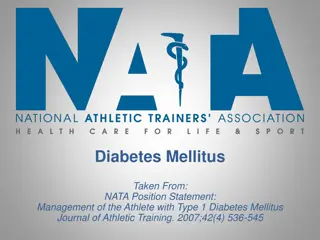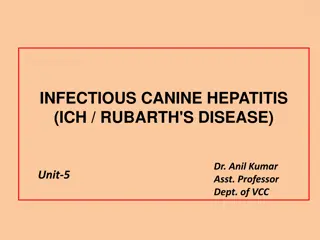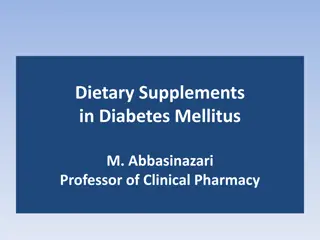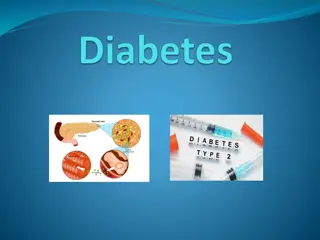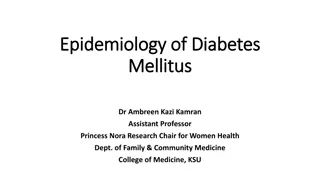Understanding Canine Diabetes Mellitus: Causes, Symptoms, and Treatment
Canine diabetes mellitus is a common disease in dogs, primarily affecting middle-aged and older dogs. Unlike Type 2 diabetes in humans, dogs mainly experience insulin-dependent Type 1 diabetes. The condition results from beta cell dysfunction in the pancreas, leading to insulin deficiency. Causes include genetic factors, environmental influences, and lifestyle aspects like pancreatitis. Proper management through insulin therapy and dietary control can help dogs live a quality life despite the condition.
Uploaded on Oct 01, 2024 | 0 Views
Download Presentation

Please find below an Image/Link to download the presentation.
The content on the website is provided AS IS for your information and personal use only. It may not be sold, licensed, or shared on other websites without obtaining consent from the author. Download presentation by click this link. If you encounter any issues during the download, it is possible that the publisher has removed the file from their server.
E N D
Presentation Transcript
Diabetes mellitus is a disease in which the beta cells of the pancreas either stop producing insulin or can no longer produce it in enough quantity for the body's needs. -The condition is commonly divided into two types : 1-depending on the origin of the condition: Type 1 diabetes, sometimes called "juvenile diabetes", is caused by destruction of the beta cells of the pancreas. The condition is also referred to as insulin- dependent diabetes, meaning exogenous insulin injections
Dogs have insulin-dependent, or Type 1, diabetes; research finds no Type 2 diabetes in dogs. -Because of this, there is no possibility the permanently damaged pancreatic beta cells could re-activate to engender a remission as may be possible with some feline diabetes cases, where the primary type of diabetes is Type 2. - There is another less common form of diabetes, diabetes insipidus, which is a condition of insufficient antidiuretic hormone or resistance to it
Diabetes mainly affects middle-age and older dogs, but there are juvenile cases. -The typical canine diabetes patient is middle-age, female, and overweight at diagnosis. -The number of dogs diagnosed with diabetes mellitus has increased three-fold in thirty years. -In survival rates from almost the same time, only 50% survived the first 60 days after diagnosis and went on to be successfully treated at home.
Classification and causes -At present, there is no international standard classification of diabetes in dogs. Commonly used terms are: 1-Insulin deficiency diabetes or primary diabetes, which refers to the destruction of the beta cells of the pancreas and their inability to produce insulin. 2-Insulin resistance diabetes or secondary diabetes, which describes the resistance to insulin caused by other medical conditions or by hormonal drugs. -Canine primary diabetes mirrors Type 1 human diabetes in the inability to produce insulin and the need for exogenous replacement of it,
-Studies have furnished evidence that canine diabetes has a seasonal connection not unlike its human Type 1 diabetes counterpart, and a "lifestyle" factor, with pancreatitis being a clear cause. -This evidence suggests that the disease in dogs has some environmental and dietary factors involved.
- Secondary diabetes may be caused by - use of steroid medications, - the hormones of estrus, acromegaly, (spaying can resolve the diabetes), - pregnancy, - or other medical conditions such as Cushing's disease. - In such cases, it may be possible to treat the primary medical problem and revert the animal to non-diabetic status.
Pathogenesis The body uses glucose for energy. Without insulin, glucose is unable to enter the cells where it will be used for this and other anabolic ("building up") purposes, such as the synthesis of glycogen, proteins, and fatty acids. Insulin is also an active preventor of the breakdown or catabolism of glycogen and fat. The absence of sufficient insulin causes this breaking-down process to be accelerated; it is the mechanism behind metabolizing fat instead of glucose and the appearance of ketones.
Since the glucose that normally enters the cells is unable to do without insulin, it begins to build up in the blood where it can be seen as hyperglycemia or high blood glucose levels. The tubules of the kidneys are normally able to re-absorb glucose, but they are unable to handle and process the amount of glucose they are being presented with. At this point, which is called the renal threshold, the excess glucose spills into the urine (glycosuria),
It is the polyuria, or over-frequent urination, which causes polydipsia, or excessive water consumption, through an osmotic process. -Even though there is an overabundance of glucose, the lack of insulin does not allow it to enter the cells. As a result, they are not able to receive nourishment from their normal glucose source. The body begins using fat for this purpose, causing weight loss; the process is similar to that of starvation
Symptoms - dog has complete cataracts; - the clouding of its eyes can be easily seen. Depending on the condition of the eyes and the overall health of the dog, it is often possible to have them surgically removed, restoring sight.
-Generally there is a gradual onset of the disease over a few weeks, and it may escape unnoticed for a while. - The main symptoms are: -excessive water consumption polydipsia -frequent and/or excessive urination polyuria possible house "accidents -greater than average appetite polyphagia with either weight loss or maintenance of current weight cloudy eyes Cataracts[
It is possible that the illness may not be noticed until the dog has symptoms of ketosis or ketoacidosis. Management Early diagnosis and interventive treatment can mean reduced incidence of complications such as cataracts and neuropathy. -Since dogs are insulin dependent, oral drugs are not effective for them. They must be placed on insulin replacement therapy. -
Approved oral diabetes drugs can be helpful to sufferers of Type 2 diabetes because they work in one of three ways: 1-by inducing the pancreas to produce more insulin, 2- by allowing the body to more effectively use the insulin it produces, 3- or by slowing the glucose absorption rate from the GI tract
The goal is to regulate the pet's blood glucose using insulin and some probable diet and daily routine changes. The process may take a few weeks or many months. - The aim is to keep the blood glucose values in an acceptable range. -The commonly recommended dosing method is by "starting low and going slow . Typical starting insulin doses are from 0.25 to 0.50 IU/kg (2.2 lb) of body weight.
During the initial process of regulation and periodically there after, the effectiveness of the insulin dose at controlling blood glucose needs to be evaluated. -This is done by a series of blood glucose tests called a curve. - Blood samples are taken and tested at intervals of one to two hours over a 12- or 24-hour period The results are generally transferred into graph form for easier interpretation. -They are compared against the feeding and insulin injection times for judgment. The curve provides information regarding the action of the insulin in the animal. -
-Other diagnostic tests to determine the level of diabetic control are fructosamine and glycosylated hemoglobin (GHb) blood tests which can be useful especially if stress may be a factor. -While anxiety or stress may influence the results of blood or urine glucose tests, both of these tests measure glycated proteins, which are not affected by them.
-Fructosamine testing provides information about blood glucose control for an approximate 2- to 4- week period, -while glycosylated hemoglobin GHb tests measure a 2- to 4-month period. -The diabetic pet is considered regulated when its blood glucose levels remain within an acceptable range on a regular basis. Acceptable levels for dogs are between 5 and 10 mmol/L or 90 to 180 mg/dL.
Insulin therapy The general form of this treatment is an intermediate- acting basal insulin with a regimen of food and insulin every 12 hours, with the insulin injection following the meal. - The most commonly used intermediate-acting insulins are NPH, also referred to as isophane,or Caninsulin, also known as Vetsulin, a porcine Lente insulin. - While the normal diabetes routine is timed feedings with insulin shots following the meals,
-Bovine insulin has been used as treatment for some dogs, particularly in the UK. Diet Most of the commercially available prescription diabetes foods are high in fiber, complex carbohydrates, and have proven therapeutic results. - Of primary concern is getting or keeping the animal eating, as use of the prescribed amount of insulin is dependent on eating full meals.
When no meal is eaten, there is still a need for a basal dosage of insulin, which supplies the body's needs without taking food into consideration. Eating a partial meal means a reduction in insulin dose. It is possible to regulate diabetes without any diet change. Semi moist foods should be avoided as they tend to contain a lot of sugars. Since dogs with diabetes are prone to pancreatitis and hyperlipidemia, feeding a low-fat food may help limit or avoid these complications.
Glucometers and urine test strips The use of an inexpensive glucometer and blood glucose testing at home can help avoid dangerous insulin overdoses and can provide a better picture of how well the condition is managed. -a diabetic pet needs to be checked at least twice a day, .
-Ketodiastix color chart for interpreting test results. This test measures both ketones and glucose in urine. -Using only one blood glucose reading as the reason for an insulin dose increase is to be avoided; - while the results may be higher than desired, further information, such as the lowest blood glucose reading , should be available to prevent possible hypoglycemia.
Urine strips are not recommended to be used as the sole factor for insulin adjustments as they are not accurate enough. Urine glucose testing strips have a negative result until the renal threshold of 180 mg/dL is reached or exceeded for a period of time. - The range of negative reading values is quite wide- covering normal or close to normal blood glucose values with no danger of hypoglycemia (euglycemia) to low blood glucose values (hypoglycemia) where treatment would be necessary.
- Because urine is normally retained in the bladder for a number of hours, the results of urine testing are not an accurate measurement of the levels of glucose in the bloodstream at the time of testing.
Glucometers made for humans are generally accurate using canine and feline blood except when reading lower ranges of blood glucose (<80 mg/dL), (<4.44 mmol/L). --All glucometer readings need to be compared to same sample laboratory values to determine accuracy
Treatment complications Hypoglycemia Hypoglycemia, or low blood glucose, can happen even with care, since insulin requirements can change without warning. Some common reasons for hypoglycemia include increased or unplanned exercise, illness, or medication interactions, where another medication potentiates the effects of the insulin. Vomiting and diarrhea episodes can bring on a hypoglycemia reaction, due to dehydration or simply a case of too much insulin and not enough properly digested food.
Symptoms of hypoglycemia need to be taken Since serious hypoglycemia can be fatal, it is better to treat a suspected incident than to fail to respond quickly to the signs of actual hypoglycemia. - "Hypoglycemia is deadly; hyperglycemia is not. Owners must clearly understand that too much insulin can kill, - Tell owners to offer food immediately if the pet is weak or is behaving strangely. - -
Symptoms of hypoglycemia Some common symptoms are:[ depression or lethargy confusion or dizziness Trembling,weakness ,ataxia (loss of coordination or balance) loss of excretory or bladder control (sudden house accident) vomiting, and then loss of consciousness and possible seizures -Successful home treatment of a hypoglycemia event depends on being able to recognize the symptoms early and responding quickly with treatment.[ - Trying to make a seizing or unconsicous animal swallow can cause choking on the food or liquid. There is also a chance that the materials could be aspirated
Treatment Food should be offered at the first signs of possible hypoglycemia. If the animal refuses it, a sugar solution (corn syrup, honey, pancake syrup, etc.) should be poured on the finger and rubbed on its gums or under the tongue (sublingually). -The solution must be applied this way to prevent possible aspiration of it. - Another hypoglycemia formula is 1 gram of glucose for every kilogram (2.2 lb) of the animal's body weight. - Since sugar acts quickly, a response should be seen within a minute or two.
Honey, syrup, or sugar, as simple carbohydrates, act rapidly and will make the blood glucose rise, but the rise will not last very long, as they are broken down quickly by the body. Feeding something containing complex carbohydrates when the pet is able to eat will make sure another hypoglycemia event does not overtake the rapid rise in blood glucose levels from the sugar solution. -
-A small meal should be fed and the animal taken for medical evaluation to determine if further treatment is needed. -Treatment of a serious hypoglycemia episode is similar to that of diabetic humans: using glucose or glucagon infusions, depending on severity





